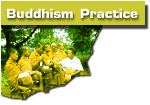 |
BANGKOK
|
||||||||
CENTRAL
|
||||||||||||
NORTHEASTERN
|
||||||||||||||
NORTHERN
|
||||||||||||
SOUTHERN
|
||||
 |
| A GUIDE TO MEDITATION CENTRES IN THAILAND |
| NORTHERN - WAT RAM POENG |
MEANING
OF NAME : |
"Monastery in memory of" (King Yod Chiengrai established the monastery in 1492 in memory of his father.) |
OTHER
NAME : |
Wat Tapotaram ("Monastery of ascetic practice") and Northern Insight Meditation Center |
ADDRESS
: |
Tambon Suthep, Amper Muang, Chiang Mai 550000 |
DIRECTIONS
: |
Located 4 km southwest of Chiang Mai. Easiest way is by tuk-tuk or bicycle. Or, take city bus #1 or songtaew west 2 km on Suthep Rd. to Phayom Market (also called Suthep), then go south 2 km to the wat (can take tuk-tuk or songtaew). Wat Umong is only 1 km to the northwest. |
TELEPHONE
: |
0-5327-8620 |
MEDITATION
SYSTEM : |
Intensive vipassana meditation based on the Four Foundations of Mindfulness. Mahasi Sayadaw techniques are used. |
TEACHING
METHOD : |
Instruction and advice are given during daily interviews. Dhamma talks in Thai are presented on the night before wan phra. |
TEACHERS
: |
Prasuprommayanna Thera (Ajahn Tong), abbot (Thai; age 68) Ven. Luang Paw Banyat Akkayano, vice abbot and head of foreign section (Thai; age 78) One or 2 English-speaking teachers assist. |
LANGUAGE
: |
The vice abbot and assistants speak English. |
DESCRIPTION
: |
Buildings
are closely spaced on the 15-rai (6-acre) grounds, with some trees
and grass. The central stupa dates back to the founding of the wat
in 1492. The glittering new building serves as the Tripitika Library;
it contains collections of the "Three Baskets" of the Theravadan
scriptures in Thai, English, Sanskrit, Sri Lankan, Burmese, Mon, Korean,
and Chinese languages. |
SIZE
: |
monks
60-70 novices about 20 nuns 60-70 laypeople 40-60 (roughly half are foreigners) |
DAILY
ROUTINE : |
Meditators are encouraged to try to practice 20 hours a day, lying down to sleep only at night. Meditation generally follows a cycle of kraap (bowing), walking, and sitting. Individual interviews take place daily (except on wan phra) in early afternoon. Practice typically begins at the 4 a.m. wakeup. Meditators have freedom to determine the schedule that works best. |
FOOD
: |
Adequate; vegetarian can be requested and is generally available. Rice porridge and a vegetable are served at 6 a.m., then the main meal at 1030 a.m. Monks and novicesgo on pindabat. |
ACCOMMODATIONS
: |
LIndividual rooms with electricity and Thai-style bathrooms (bathing from jars; Asian- and a few western-style toilets) with running water. |
WRITE
IN ADVANCE? : |
Recommended, because the centre is often full. If all rooms are full, you can sign up on a waiting list. Alternate accommodations may be available too. Writing, or better visiting, in advance enables you to reserve a space. Busiest times are the tourist season (Oct.through March) and the Rains Retreat (3-month period beginning mid- or late July). Preference is given to those planning on staying at least 26 days for the whole course and those who have practiced here before. |
OTHER
INFORMATION : |
The
course takes 26 days to complete; a stay of onemonth is a bit better.
Because practice is individual, you can arrive and begin at any time.
Meditators may be accepted for shorter periods if space is available.Eight
precepts are observed. Traditional white clothing is worn. Teachers
allow some socializing, though care should be taken not to talk about
or disturb others' meditation. A small foreign library has books in English and a few other languages, Dhamma talks on tapes, and books and tapes for learning Thai. The library is available to meditators who have finished the 26-day course and to outside visitors. The wat is popular with both westerners and Thais. Like Wat Umong, this monastery fell into disuse sometime after its founding. During WW II,Japanese troops occupied and badly damaged the site. Reconstruction of the viharn began in 1971. In 1974, Prakrupipatkanapiban, the abbot of Wat Muang Mang and head teacher of a meditation school in Chiang Mai, came here and stayed; he's the current abbot and now has the name Prasuprommayanna Thera. Meditation courses at Wat Ram Poeng began in 1975. |
| Select here : |
|
|